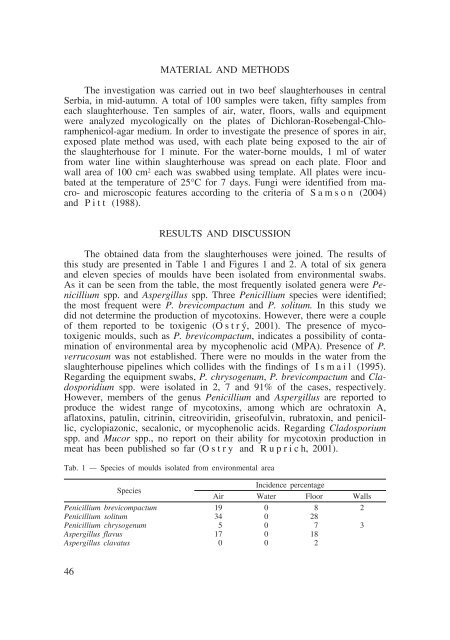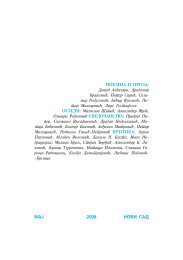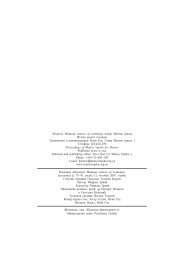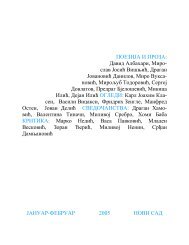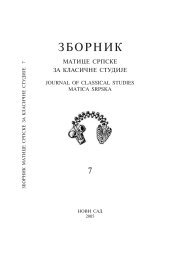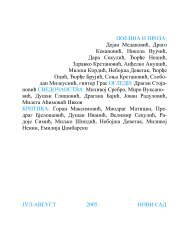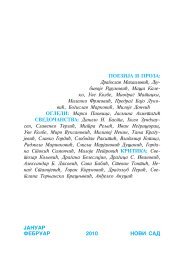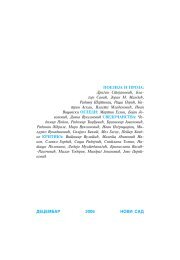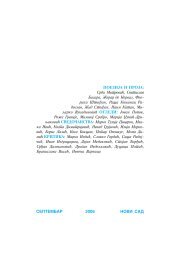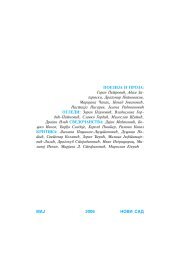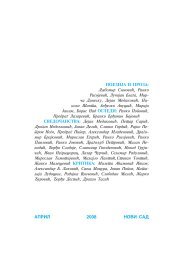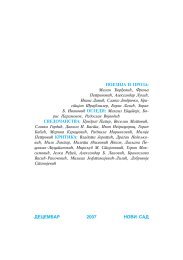ЗБОРНИК - Matica srpska
ЗБОРНИК - Matica srpska
ЗБОРНИК - Matica srpska
Create successful ePaper yourself
Turn your PDF publications into a flip-book with our unique Google optimized e-Paper software.
MATERIAL AND METHODS<br />
The investigation was carried out in two beef slaughterhouses in central<br />
Serbia, in mid-autumn. A total of 100 samples were taken, fifty samples from<br />
each slaughterhouse. Ten samples of air, water, floors, walls and equipment<br />
were analyzed mycologically on the plates of Dichloran-Rosebengal-Chloramphenicol-agar<br />
medium. In order to investigate the presence of spores in air,<br />
exposed plate method was used, with each plate being exposed to the air of<br />
the slaughterhouse for 1 minute. For the water-borne moulds, 1 ml of water<br />
from water line within slaughterhouse was spread on each plate. Floor and<br />
wall area of 100 cm 2 each was swabbed using template. All plates were incubated<br />
at the temperature of 25°C for 7 days. Fungi were identified from macro-<br />
and microscopic features according to the criteria of S a m s o n (2004)<br />
and P i t t (1988).<br />
RESULTS AND DISCUSSION<br />
The obtained data from the slaughterhouses were joined. The results of<br />
this study are presented in Table 1 and Figures 1 and 2. A total of six genera<br />
and eleven species of moulds have been isolated from environmental swabs.<br />
As it can be seen from the table, the most frequently isolated genera were Penicillium<br />
spp. and Aspergillus spp. Three Penicillium species were identified;<br />
the most frequent were P. brevicompactum and P. solitum. In this study we<br />
did not determine the production of mycotoxins. However, there were a couple<br />
of them reported to be toxigenic (O strþ, 2001). The presence of mycotoxigenic<br />
moulds, such as P. brevicompactum, indicates a possibility of contamination<br />
of environmental area by mycophenolic acid (MPA). Presence of P.<br />
verrucosum was not established. There were no moulds in the water from the<br />
slaughterhouse pipelines which collides with the findings of I s m a i l (1995).<br />
Regarding the equipment swabs, P. chrysogenum, P. brevicompactum and Cladosporidium<br />
spp. were isolated in 2, 7 and 91% of the cases, respectively.<br />
However, members of the genus Penicillium and Aspergillus are reported to<br />
produce the widest range of mycotoxins, among which are ochratoxin A,<br />
aflatoxins, patulin, citrinin, citreoviridin, griseofulvin, rubratoxin, and penicillic,<br />
cyclopiazonic, secalonic, or mycophenolic acids. Regarding Cladosporium<br />
spp. and Mucor spp., no report on their ability for mycotoxin production in<br />
meat has been published so far (O s t r y and R u p r i c h, 2001).<br />
Tab. 1 — Species of moulds isolated from environmental area<br />
Species<br />
Air<br />
Incidence percentage<br />
Water Floor Walls<br />
Penicillium brevicompactum 19 0 8 2<br />
Penicillium solitum 34 0 28<br />
Penicillium chrysogenum 5 0 7 3<br />
Aspergillus flavus 17 0 18<br />
Aspergillus clavatus 0 0 2<br />
46


